The Data
As all the testing was performed with the exact same equipment (except the 140mm Noctua Industrial fans replace the 120mm GT fans), using the exact same methods as was used in the 360mm round-up we have decided to keep this review uncluttered by keeping our testing methodology, test set-ups and equipment used in a single location. To see exactly how the tests were carried out, details of the test set ups and equipment used, please head over to the RRU Test Setup page.
Restriction Test
It is generally agreed that radiators are one of, if not the least restrictive components in the water cooling loop. There are some exceptions however, so this must still be verified through testing:
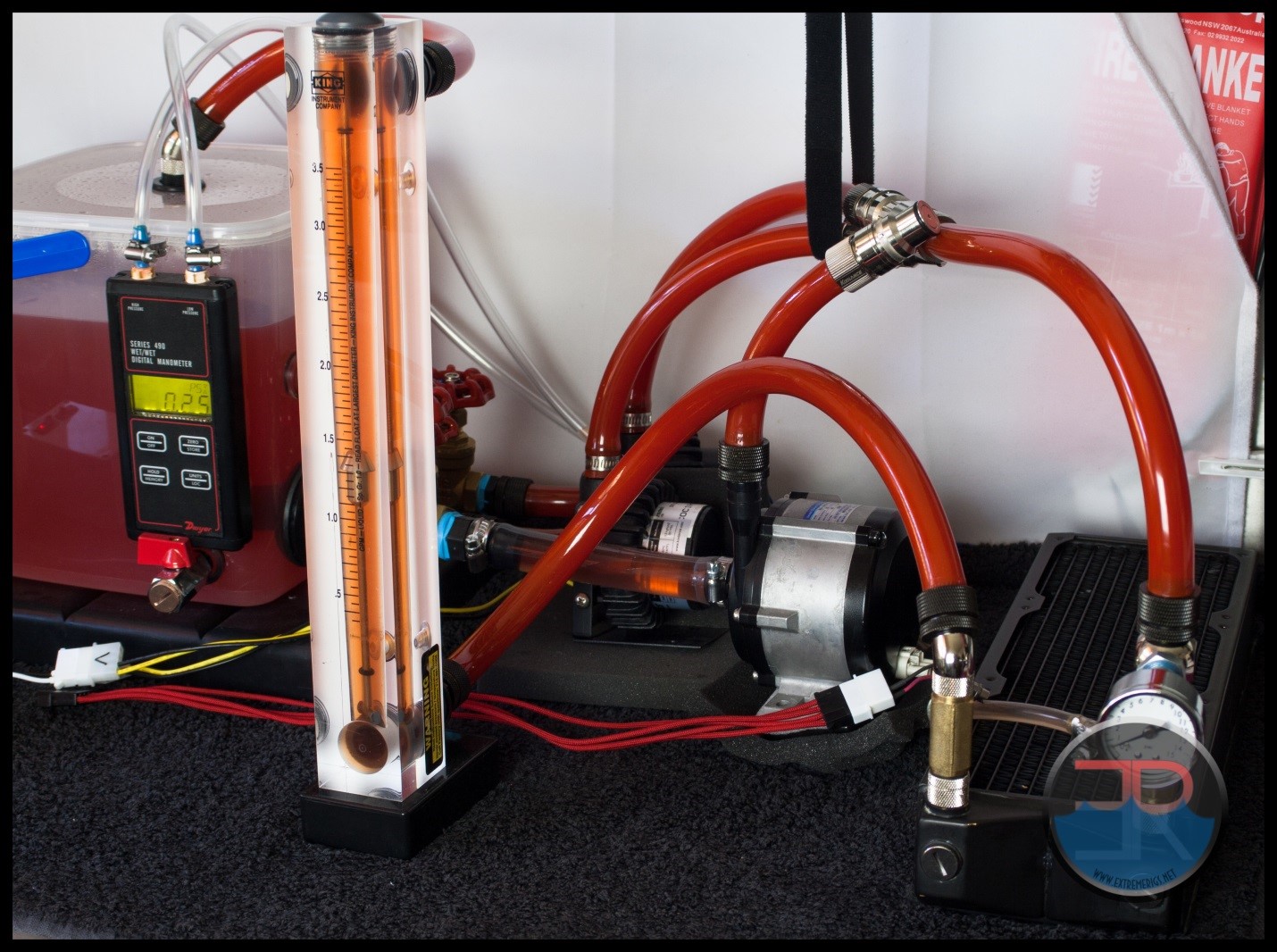 The above photo is for referencing the restriction test bench The Nemesis 280 GTS is not loaded so please disregard the data in the picture as it does not relate to the its test results.
The above photo is for referencing the restriction test bench The Nemesis 280 GTS is not loaded so please disregard the data in the picture as it does not relate to the its test results.
Here is the raw data at the tested flow rates, displaying the measured Differential Pressure across the radiator as flow rate was increased.
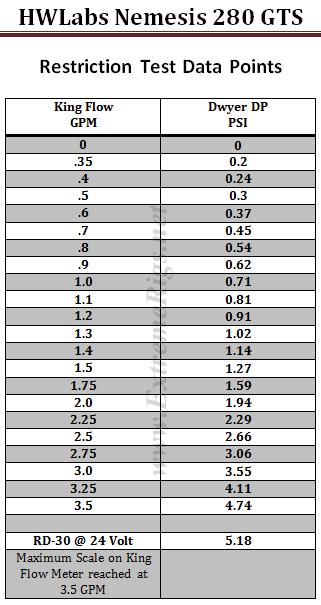 The table numbers indicate that the Nemesis 280 GTS could be one of the exceptions, as these numbers look quite high. However numbers in isolation can only tell half the story. By plotting against other components it more easily shows the whole story.
The table numbers indicate that the Nemesis 280 GTS could be one of the exceptions, as these numbers look quite high. However numbers in isolation can only tell half the story. By plotting against other components it more easily shows the whole story.
We use a HeatKiller 3.0 CPU block as the reference in this next plot for two reasons. Firstly there is little chance of the plot being cluttered by curves overlapping and secondly it gives a reference point against a fairly common loop component of average restriction.
As with all previous radiator restriction plots, we have limited the maximum flow rate displayed to 2.0 GPM as we suspect there are very few systems that operate above 2.0 GPM. For more information on how to read a restriction plot check out our guide.
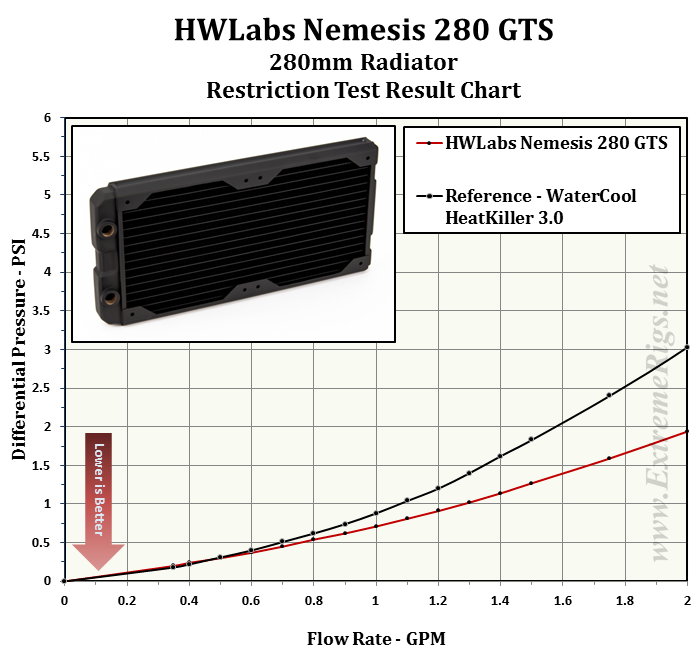 This plot indicates the Nemesis 280 GTS is an average restriction loop component when compared to a CPU block of average restriction, but what about other radiators?
This plot indicates the Nemesis 280 GTS is an average restriction loop component when compared to a CPU block of average restriction, but what about other radiators?
The next three plots show the restriction level at three different flow rates compared to the other 280mm radiator that have been tested. We consider the chosen GPM rates to represent systems which have low, medium and high flow rates.
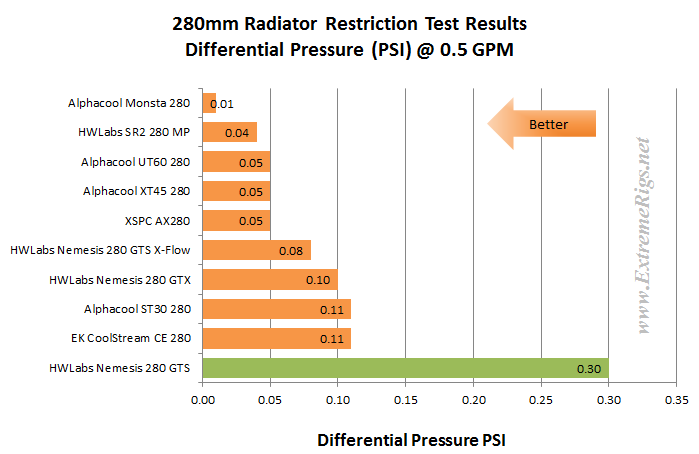 That is very high indeed compared to the other 280mm radiators.
That is very high indeed compared to the other 280mm radiators.
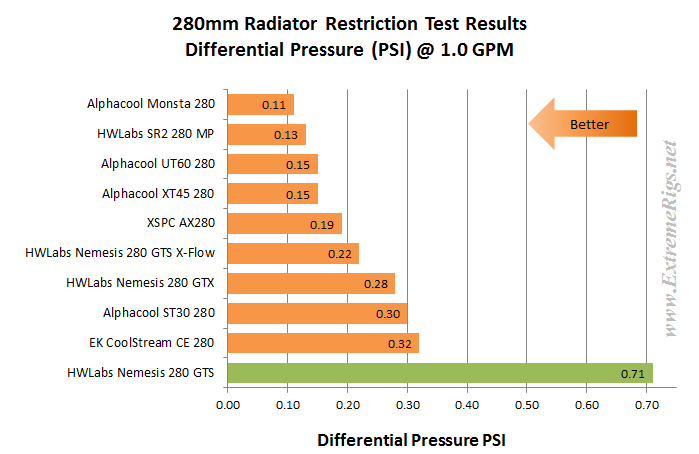 In general we try to aim for ~1.0 gpm flow rate and we know a D5 pump at full power with a decent after market top puts out ~4.5 PSI at 1.0 GPM. Therefore we can determine that the Nemesis 280 GTS will take about 15% of the pump’s output to keep a 1.0 gpm flow rate.
In general we try to aim for ~1.0 gpm flow rate and we know a D5 pump at full power with a decent after market top puts out ~4.5 PSI at 1.0 GPM. Therefore we can determine that the Nemesis 280 GTS will take about 15% of the pump’s output to keep a 1.0 gpm flow rate.
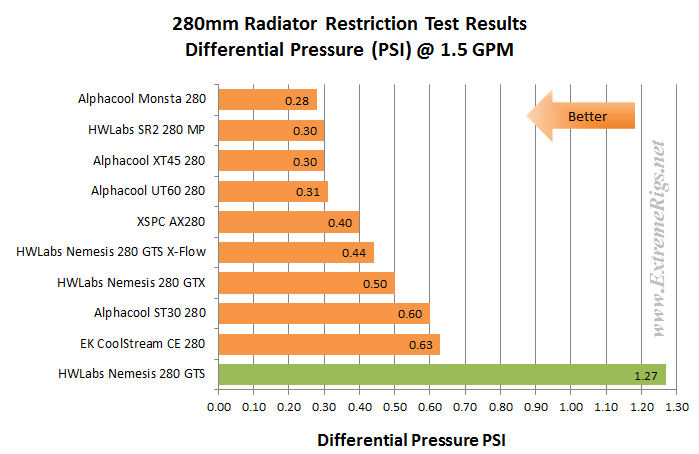
The Nemesis 280 GTS is the most restrictive of all the radiators in the test group at all flow flow rates which were chose to compare against. Remembering that in general radiators are low restriction components, the Nemesis 280 GTS’s high restriction level appears worse (and let’s be honest it is high) because the data it is being compared against other radiators which are low in restriction.
A zoomed in plot showing a flow rate zone where most systems are likely to be operating at.
I dare not look at percentage differences for the data, but lets just say that the Nemesis 280 GTS is a lot more restrictive then the other 280 mm radiators.
Let’s now take a look at where the Nemesis 280 GTS fits in relation to all the radiators we have tested. For this plot, only results for 1.0 GPM have been used for the comparison.
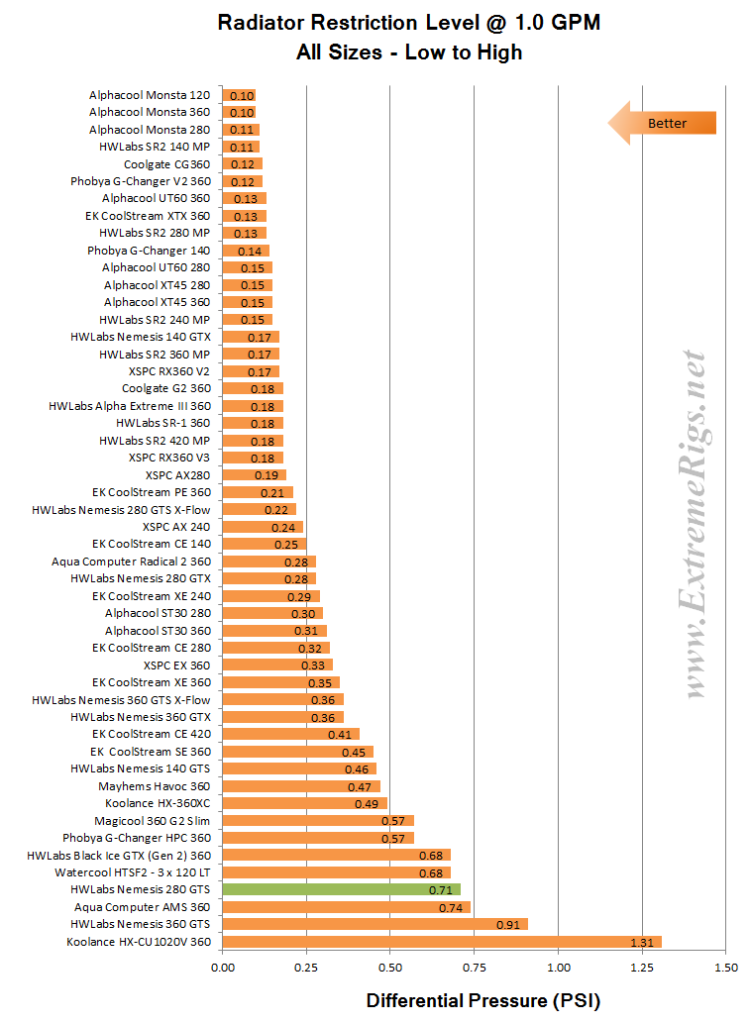 When put into context with all the radiators at 1.0 gpm, the Nemesis 280 GTS fits into our criteria as a very restrictive radiator. We consider this borderline unacceptable and care will have to be taken with loop design and pump power carefully considered if more than 1 Nemesis GTS series radiator is to be used.
When put into context with all the radiators at 1.0 gpm, the Nemesis 280 GTS fits into our criteria as a very restrictive radiator. We consider this borderline unacceptable and care will have to be taken with loop design and pump power carefully considered if more than 1 Nemesis GTS series radiator is to be used.
It is only the Dual Pass Nemesis GTS series which are so restrictive as can be seen in the following plot which shows restriction levels at 1.0 gpm for many current model radiators from Hardware Labs.
Next onwards to Thermal Performance.







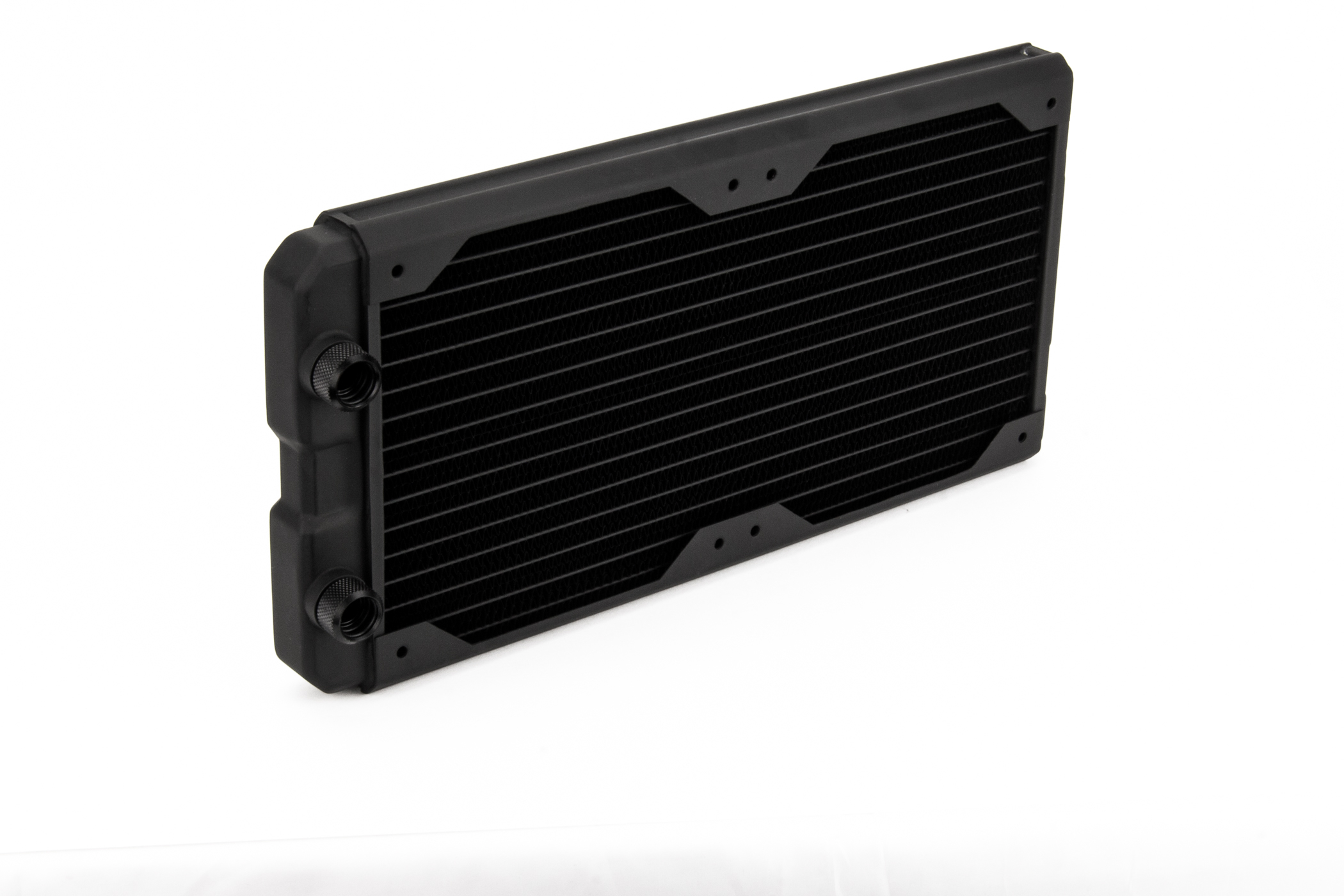
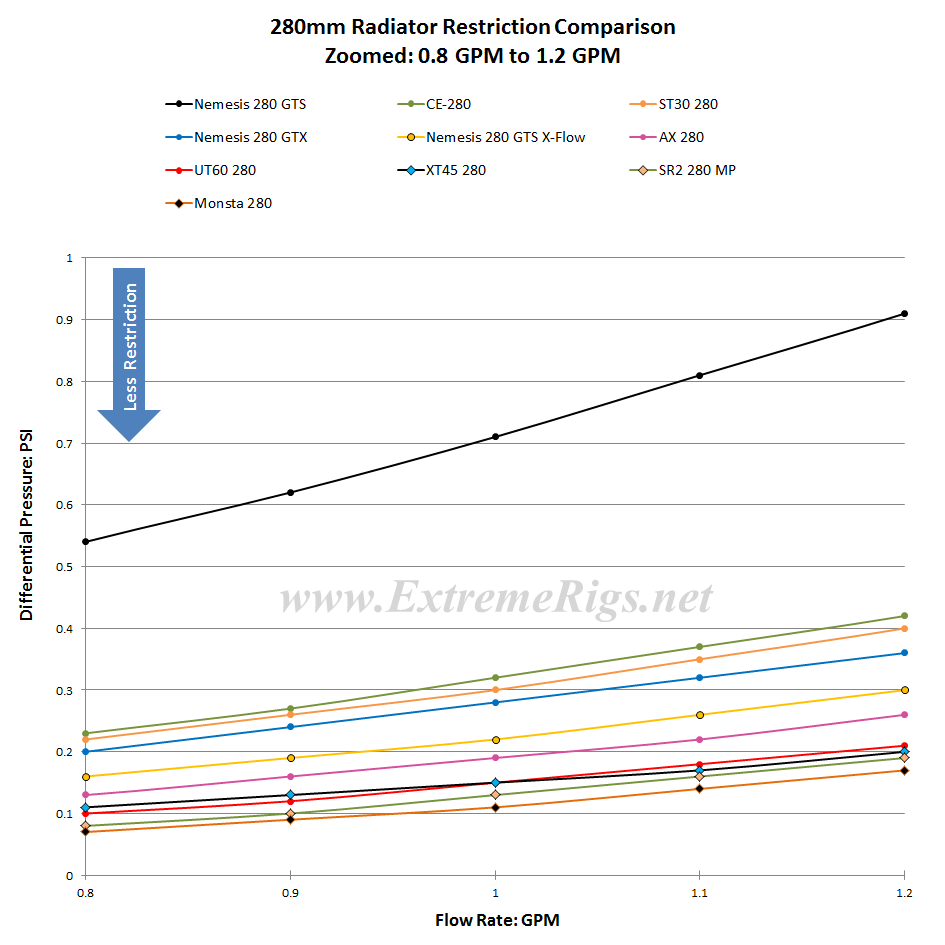




Another great radiator review! I love the exact TDP dissipation numbers at different fan speeds.
The GTS series looks like the radiator to beat in the thin category. I especially like the fact that these are non-louvered designs which seem to require less static pressure than louvered, and obviously “store” less dust. I have both the white GTS and GTX radiators in 280mm, as well as an L-Series which is a bit easier to fit because it has the reduced width. All have been great even at low fan speeds. I have a crossflow 280GTS and a 280GTS L-series in a modified Corsair 350D with hih airflow front panel, with push only Thermaltake Riing fans (140mm) and they cool my i7 5960x at 4Ghz and my 980Ti at 1.55ghz (I got lucky) amazingly at 1000 RPM. Highest temps on the i7 5960x at 1.20 volts are 65 celsius (except with Prime 95 AVX which goes to 75) and the 980Ti is only at 43 celsius at full bore, and my water temps are only around 6-8 celsius Delta-T. Amazingly quiet and cool. I could theoretically add another 980Ti to the loop with only a slight increase in fan speeds and not have to worry about over-subscribing the water cooling loop, based on the heat dissipation potential shown here.
Comments are closed.